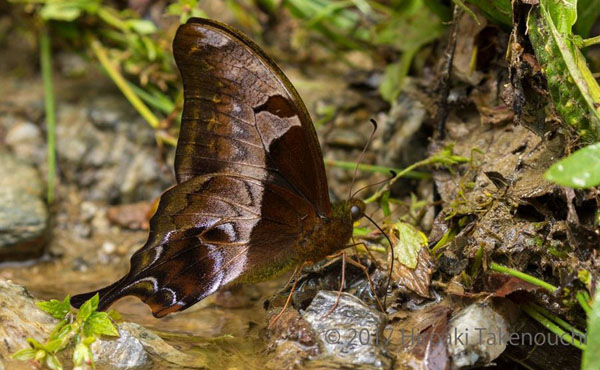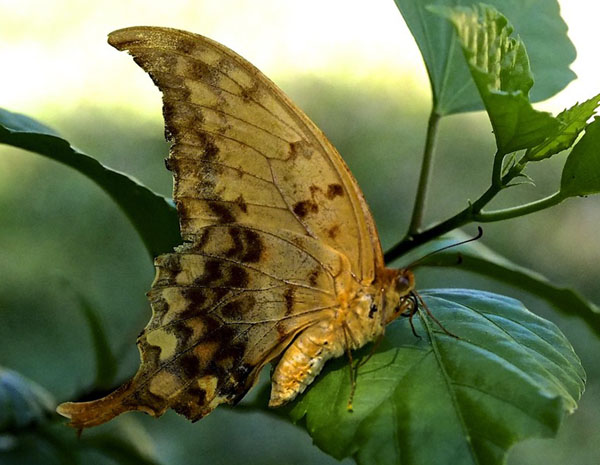Brown Gorgon
Meandrusa lachinus
first update d. 1 october 2024
last update d. 1 october
2024

Brown Gorgon,Meandrusa lachinus (Fruhstorfer,
1902) male.
Arunachal
Pradesh, Indien d. 27 august 2017. Photographer; Hiroaki
Takenouchi
Brown Gorgon, Meandrusa
lachinus (Fruhstorfer, 1902)
male.
Appearance:
Meandrusa sciron (Leech,
1890) female.
Synonyms:
Papilio sciron (Leech,
1890) female
Papilio lachinus
(Fruhstorfer, 1902) male
Male:
Upperside opaque brown, the basal area and the
terminal third of both forewings and hindwings of
a darker shade than the broad medial area, due to
the dark markings of the underside that show
through by transparency;
forewings and hindwings with a subterminal series
of largish yellow lunules that curve upwards
posteriorly on the hindwing and end in a diffuse
transverse bluish-white mark across interspace 1.
Underside, forewing: basal third and a large spot
on the discocellulars, that is widened
anteriorly,
rich dark cinnamon-brown; medial third lilacine,
pale towards the dorsum, widened anteriorly and
extended into the apex of the cell, and on the
costa from the discocellulars to near the apex of
the wing; interspaces 2, 3 and 4 with paler
lilacine (lilac-coloured) lunules; terminal third
of the wing dull brown, with a postdiscal and a
subterminal transverse series of somewhat obscure
olivaceous-yellow lunules.
Hindwing: basal third rich dark cinnamon brown in
continuation of that colour on the forewing;
remainder of the wing lilacine, with a large
posterior discal patch of cinnamon brown,
margined inwardly by a diffuse broad irregular
white band, and outwardly by a series of white
lunules; a subterminal somewhat obscure row of
olivaceous-yellow markings; the tail and terminal
margin dark cinnamon brown. Antennae dark brown,
head, thorax and abdomen brown with an olivaceous
tinge; beneath: similar, the abdomen more
brightly olivaceous yellow.
Female:
Upperside: ground colour similar to that in the
male; marking differ as follows: a very broad
discal transverse lilacine white band across both
forewings and hindwings that extends from vein 5
and from within the apex of cell of forewing to
the dorsal margin of the hindwing.
Forewing: a yellowish-white costal spot in upper
third of cell, a larger spot beyond that turns to
yellow at base of interspace 6, an anterior
postdiscal transverse series of yellow more or
less lunular spots, and a subterminal similar
series of spots.
Hindwing: the lilacine white colour of the discal
band spreads to the base of the wing, but is
thickly irrorated (sprinkled) with brownish
scales, as is also the outer margin posteriorly
of the same band; the rest of the wing dark
brown, with the margins of the tornus and of the
tail broadly bright cinnamon brown; lastly,
superposed on the brown area is a sub-terminal
series of large, yellow, well-defined more or
less lunular spots. Underside similar to that of
the male, the ground colour and markings on the
outer two-thirds of both forewing and hindwing
paler. Antennae, head, thorax and abdomen as in
the male.
Karl Jordan in Seitz (page
91) provides a description differentiating gyas
from nearby taxa and discussing some forms.
Subspecies:
Meandrusa sciron sciron (Leech,
1890) female.
Ssp.: M. abaensis
(Sugiyama, 1994). China: Sichuan.
Ssp.: aribbas
(Fruhstorfer, 1909) western China, Myanmar.
Ssp.: dalata
(Monastyrskii & Devyatkin, 2003). Vietnam.
Meandrusa lachinus
(Fruhstorfer, 1902). India:Senchal, Darjeeling.
Ssp.: nagamasai (Okano,
1986). Thailand.
Distribution: Brown
Gorgon, Meandrusa sciron, is a
species of swallowtail butterfly found in parts
of South Asia and Southeast Asia. It belongs to
the hooked swallowtails genus, Meandrusa, of the
family Papilionidae. The brown gorgon is found in
India from Sikkim to Assam and north Burma and is
not considered to be threatened. Though not
uncommon, it is protected under Indian law under
the name gyas.
Habitat: flies in forests from
1,500 to 2,700 m.
It generally sticks to the ridges rather than the
valleys.
Behaviour:
Flight time: It is known to have
two generations,
the first in May and June and the second from
August to October
Egg. Larva and pupa: Probably
unpleasant due to its host plant being Aristolochia species.
Host plants: Larvae on Lauraceae species.
Distribution: Brown
Gorgon, Meandrusa sciron, is a
species of swallowtail butterfly found in parts
of South Asia and Southeast Asia. It belongs to
the hooked swallowtails genus, Meandrusa, of the
family Papilionidae. The brown gorgon is found in
India from Sikkim to Assam and north Burma and is
not considered to be threatened. Though not
uncommon, it is protected under Indian law under
the name gyas.
Named in English: Brown
Gorgon.
Similar species:
Meandrusa Moore, 1888
(4 species) |
| 1 |
Meandrusa
gyas (Westwood, 1841)
Brown Gorgon. Sikkim to Assam and Upper
Burma, as well as in Thailand. |
| |
Meandrusa
lachinus (Fruhstorfer,
1902) India: Senchal, Darjeeling |
| |
Meandrusa payeni (Boisduval,
1836) Yellow Gorgon. South Asia and
Southeast Asia. |
| 4 |
Meandrusa
sciron (Leech, 1890)
Eastern Brown Gorgon. India from Sikkim
to Assam and north Burma. |
Reference:
Lepidoptera and some other life
forms
Wikipedia:
Butterfflies of India
GBIF: Global Biodiversity
Information Facility.
World distribution:
Brown Gorgon, Meandrusa sciron (Leech,
1890) male.
Wikipedia: Bhutan's
Glorie, Bhutanitis
lidderdalii (Atkinson, 1873).
Hiroaki Takenouchi Facebook:
_____________________
|
___________________________________
Yellow Gorgon
Meandrusa payeni
first update d. 1 october 2024
last update d. 1 october
2024

Yellow Gorgon, Meandrusa payeni ssp. evan (Doubleday,
1845) male.
Mawlynnong 475m., East Kashi Hills, Meghalaya, India d. 23 october
2016.
Photographer: Pamela Donaldson
Yellow Gorgon, Meandrusa
payeni ssp. evan
(Doubleday, 1845) male.
Family: is a species of swallowtail found in
parts of South Asia and Southeast Asia. It
belongs to the hooked swallowtails, genus Meandrusa, of the
family Papilionidae. It is
also called the outlet sword or the sickle.
Description: Upperside bright ochraceous, with a
darker shade towards the base of the wings.
Forewing: two or three spots obliquely across the
cell, a larger spot at its upper apex, the costal
margin from base (the collar broadened towards
the apex), and the terminal margin very broadly,
dark brown; on the inner side of this broad brown
terminal edging there is a transverse incomplete
discal series of dark brown spots, followed by an
irregular transverse series of brown lunules,
both these merge anteriorly and posteriorly into
the brown on the termen; lastly superposed on the
brown terminal edging is a more or less complete,
transverse, subterminal series of lunules of the
ochraceous ground colour, reduced in some
specimens to only two or three lunules above the
tornus.
Hindwing: terminal half or more dark brown, with
an inner postdiscal and an outer subterminal
series of more or less lunular spots of the
ochraceous ground colour; the postdiscal series
consists of only four spots in interspaces 1 to
4, the subterminal series is complete to
interspace 7, the spots larger, that in
inter-apace 3 elongate, outwardly conical; tail
tipped with ochraceous. underside: ground colour
a deeper richer ochraceous.
Forewing: cell and basal area with a number of
irregular cinnamon-brown spots, followed on the
terminal half by three transverse series of more
or less irregular and incomplete lunular
cinnamon-brown markings and a narrow brown
terminal edging.
Hindwing: basal area with a transverse series of
three spots, a large spot at apex of cell, the
bases of interspaces 1, 2 and 3, followed by
three more or less complete but irregular series
of lunular markings, cinnamon brown; superposed
on the inner discal row of brown lunules is a
transverse series of snow-white crescents,
conspicuous only in interspaces 1 and 2, but
barely indicated anteriorly.
Antenna dark ochraceous brown; head, thorax and
abdomen ochraceous, the thorax posteriorly and
basal half of the abdomen olivaceous; beneath:
head, thorax and abdomen brighter ochraceous.
Female: Ground colour paler, base and cell of
forewing on upperside shaded with bright very
pale cinnamon; markings similar both on the upper
and under sides, but less clearly defined; the
costal margin of forewing on the upperside
ochraceous almost to apex, not brown; the
subterminal series of ochraceous lunules on the
upperside of the hindwing very large, separated
from one another only by the brown along the
veins. Antennae, head, thorax and abdomen
similar, but paler.
Karl Jordan in Seitz (page
91, 92) provides a description differentiating
payeni from nearby taxa and discussing some
forms.
Larva food plants / other food objects:
Litsea cubeba, the aromatic
litsea or may chang, is an
evergreen tree or shrub 5–12 meters high in
the family Lauraceae. It is
native to Southern Chinese regions including
Sichuan, Guizhou, Yunnan, and Fujian as well as
Taiwan and other Southeast Asian countries such
as Indonesia, Malaysia and Cambodia. It is called
"mountain pepper".
Species: Meandrusa
payeni ssp. payeni (Boisduval,
1836). Java.
Subspecies.: brunei (Fruhstorfer,
1894) northern Borneo.
Ssp.: ciminius
(Fruhstorfer, 1909). Burma to Peninsular Malaya,
Sumatra.
Ssp.: evan
(Doubleday, 1845). Bhutan, India: Sikkim, Assam.
Ssp.: hegylus (Jordan,
1909). China: Hainan.
Ssp.: langsonensis
(Fruhstorfer, 1901), northern Vietnam.
Distribution: The butterfly is
found in India from Sikkim to Assam, north Burma
and Peninsular Malaysia.
Status: The yellow
gorgon is not threatened, but is not
common across most of its range. However it is
considered to be vulnerable and in need of
protection in Peninsular Malaysia.
___________________________________
Reference:
Lepidoptera and some other life
forms
Wikipedia:
Butterfflies of India
GBIF: Global Biodiversity
Information Facility.
World distribution:
Yellow Gorgon, Meandrusa payeni
ssp. evan
(Doubleday, 1845) male.
|
___________________________________
|

